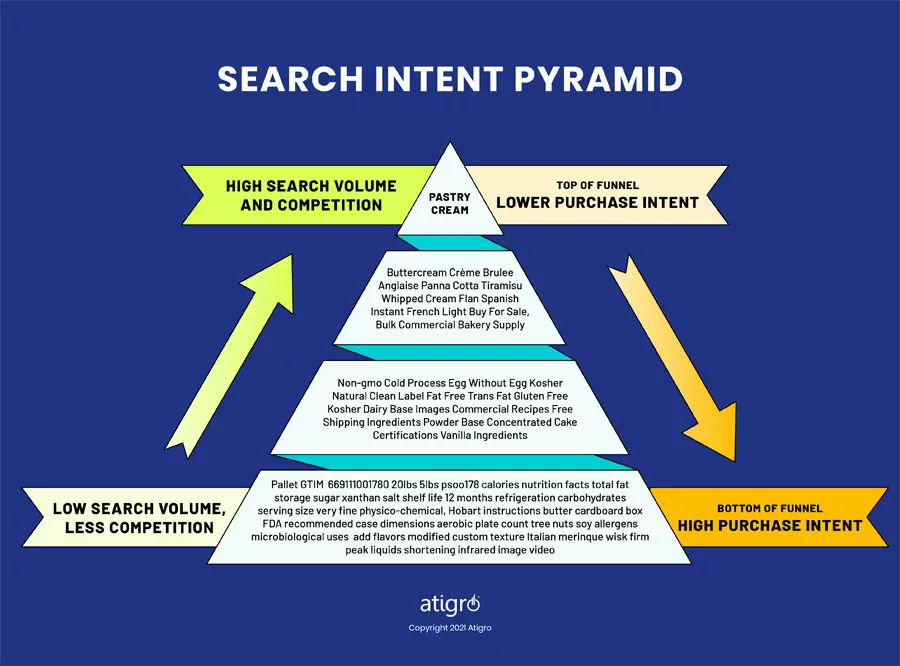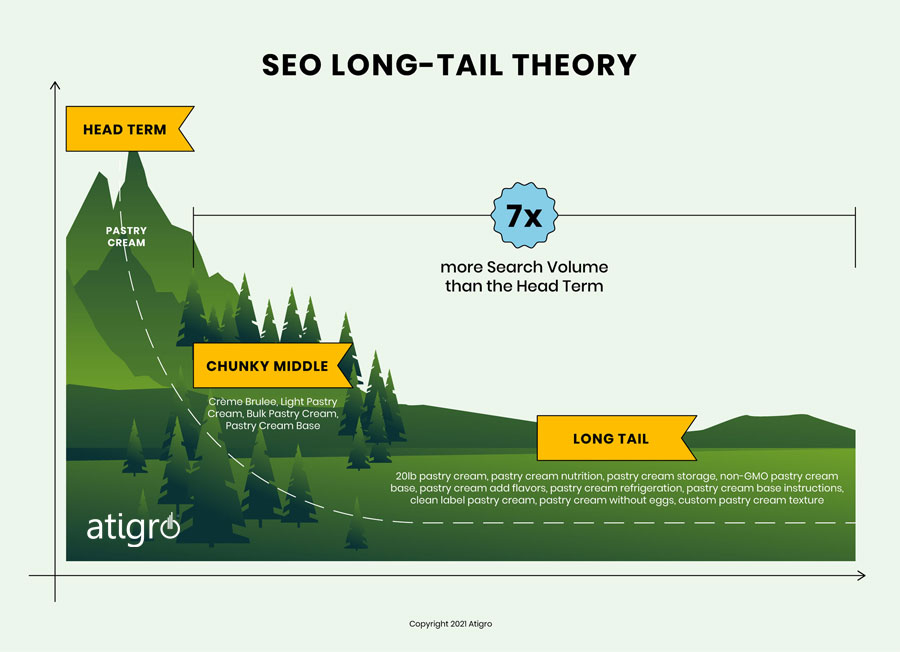What are Long-Tail Keywords?
What is a Head Term?
What is Meant by Buyer Intent?
Part 1 of SEO Strategy for the Rest of Us
A series explaining SEO strategy so business leaders can be more effective in search
When you’re looking to improve your search engine optimization results and gain more traffic from Google to your website, it all starts with an effective content strategy. A solid content strategy is vital to SEO because its purpose is increasing site visibility. A common mistake is to think a keyword strategy means that content writers must insert a list of keywords into the website or blog. Those days, like MC Hammer pants, are long gone from many Google algorithm updates.
Keyword Strategy and Its Importance to SEO
Keywords – topics that your content is about – are essentially the connection between what your target audience is searching for and your content. Keywords are more about your target audience than about your content. Everyone speaks and writes differently so you may describe your services and product offerings differently than how your target audience may search for it. Understanding this principle in keyword strategy is valuable to more successful SEO planning and execution.
Content is king… well really, content strategy is
Today, succeeding in search is all about E-A-T, which we will discuss in detail in an upcoming article. First and foremost, you must craft an effective content strategy. When you deliver content that consistently provides valuable information to your targeted audience, it demonstrates to Google that you are an Expert, have Authority and are Trustworthy (EAT). The content you create with a good strategy will naturally have all the keywords necessary because you are focused on meeting your audience’s needs. Your keywords might not be the exact keywords you found by using SEMrush, BrightEdge or whatever tools you’re using, but if it meets the searcher’s needs or matches a searcher’s intent, there’s a really good chance your content will perform well.
In this three-part series, we’ll explore the fundamentals of keyword strategy, including head terms, the chunky middle, and long-tail keywords. Once you understand these concepts, you have the foundation to make smarter decisions about your SEO strategy.

Search Intent Pyramid with Sample Keywords
Recently, we crafted a content strategy for a pastry ingredient provider and considered the value of product category and product detail pages. The concern was whether traffic to these pages would match the target audience: B2B bulk buyers (not consumers). When you factor in that their product descriptions have commercial buyer indicators, such as 25 lb. bulk packaging, yields 1,000, and 12-month shelf life, it is appropriate to include them. This example is illustrated in the Search Intent Pyramid above. It shows the sample head term “pastry cream” and 3 more layers of long-tail keywords. As you move down the pyramid, the keywords are less frequently used but have higher buyer intent.
In the second layer (just under “pastry cream”), the terms are slightly more specific and a little less frequently searched than “pastry cream” – a broad term. These keywords demonstrate more relevance and buying intent – perhaps, your searcher is just getting started gathering general information.
In the third layer from the top, the terms become even more specific and less frequently used than “buttercream brulee” or “pastry cream,” for instance. These terms are getting closer but still not considered a strong intent to buy by the searcher – your searcher is likely comparing options and narrowing their list.
In the bottom layer, these terms become very precise and specific. These terms are used when a searcher is ready to purchase. While they are used the least, they indicate the searcher has a very specific need to fill or problem to solve right now. It is “ground zero” for long-tail terms – words that best meet the searcher’s intent and likely have the highest engagement and conversion.
Of course, our audience doesn’t usually go through this entire process – starting with a head term and narrowing a search to get more specific. Most searchers know that if they’re very specific in the initial query that they’re more likely to find exactly what they’re looking for. Therefore, the long tail is key to our success in SEO.
What are Long-Tail Keywords?
Long-tail keywords are longer, more specific phrases often used by potential customers when they are ready to make a purchase or know exactly what they’re looking for. Because of their specificity, these “individual phrases” are searched much less frequently. However, they often have higher buyer intent and are less competitive than words or phrases that are considered “head terms.” Wholesale Bakery is a head term. Conversely, 50 pounds all-purpose flour is considered a long-tail term because of its specificity.
What is a Head Term?
Head terms are the keywords it seems everyone wants to rank in the top 10 on Google: auto insurance, bitcoin, healthcare – to name a few. Head terms are searched for very frequently but generally have less “buyer intent.” Usually, searchers are “just browsing” when they do head-term searches. They might not even know what they want yet.
What is Meant by Buyer Intent?
Buyer intent is the probability that a searcher using a keyword (or phrase) is likely to be a qualified prospect and ready to buy.
Salespeople know when a prospect starts asking “buying questions” – very detailed questions used when considering whether or not to buy, it is the time to close the sale. Marketers know that answering those specific buying questions in their content not only helps them attract customers ready to purchase but makes them more likely to buy.
While people often think of head terms as being the primary goal of SEO, statistically, long-tail keywords have more buyer intent. Think of your own search behavior, if you google “wedding cakes,” how probable is it that you are just browsing? Whereas, if you search for “3-tier, white stucco, raspberry filling wedding cake” chances are you are ready to purchase when a local bakery comes up in Google with a picture of that cake.
Isn’t Search Frequency Everything?
Search frequency, or how often a keyword is searched, is an important consideration. Sure, you’d like to rank for them, but because of how competitive they are it might not be possible. A great content strategy and execution of that strategy can help you rank for the right keywords. In fact, as you can see in the graph below, the long tail and chunky middle have a combined search volume which is 7x the search volume of a typical head term. A strategy which focuses on the long tail will produce results faster, better quality traffic and the potential to deliver higher traffic volume overall.
Share this image on your site
Atigro CEO, Ken Fischer came up with the concept of a multiple-dimensional mountain range as a way to visualize long-tail theory for content marketing and keyword strategy. This improves upon the one-dimensional graphs commonly used. There’s a summit (head term), peaks (chunky middle), foothills (long-tail) and valleys (very long-tail). This “long-tail theory mountain range” actually extends off the image to the left, in the background and in the foreground with additional mountains with their own summits, peaks and foothills. Additionally, there are new mountain ranges which might represent new ideas, products, services or content topics you’ve yet to consider.
But wait, I want to rank for all of these terms!
To do this effectively, you will need to craft a SEO strategy where your site ranks for keywords that are not as competitive but have strong buyer intent for your products. Niche brands have the potential to dominate the long tail, but typically need to build authority over time by investing in SEO, high quality content, “white hat” or “honest link building” and start at the bottom of the keyword pyramid and work their way up.
What about Searchers Who Aren’t a Good Match for Us?
There is no doubt that your content and keyword strategy may drive some unintended visitors to your website – those who are not your target audience. Descriptive title tags and meta-descriptions that resonate with the right audience can help minimize this but in our commercial bakery products client example, they will likely get individual consumers or home cooks that don’t purchase bulk items. But, this is a problem you want to have. There’s no harm unless you’re intentionally enticing click-throughs from the wrong audience. And, you may be surprised that some home cooks actually place an order or share your brand with someone who is a good match. What effort is it to vet online leads compared to going after sales through sales reps? Typically, you have a much higher ROI by weeding out online leads than going after targeted leads who traditionally are not ready to purchase your product or service.
My buyers don’t search for vendors online.
Often, it’s even tempting to assume that B2B buyers don’t search for products at all. More and more, as digital habits become more pervasive across age groups and industries, we are finding that those digital habits developed at home as a consumer are being brought to the office regardless of industry.
What to Do When Creating a Content Strategy
It is necessary to do keyword research to understand the keywords your audience uses on Google. But writers should use the research as information and insights into the buyer’s intent, not to cram keywords into the copy. Use keyword research to make sure you’re leaving no questions unanswered in your article, blog, etc. and to thoroughly understand your topic and keyword universe. Then, produce a flushed out content calendar with an endless source of content ideas that will add a depth and breadth to your content. Over time, this will improve EAT in the eyes of Google and your audience. You’ll get more traffic from more keywords than you’ve ever imagined.
Reach out today to learn more about our SEO audit to build an effective SEO strategy.
Next up
Part 2: Align Your Site Structure with Your Keyword Strategy


